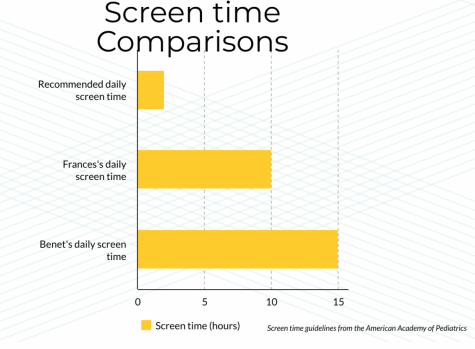Opinion: What happened to screen time guidelines?
As distance learning remains in place, students have found more of their time being spent on electronic devices than when in-person learning was happening. Photo by: Anna Guerra.
October 27, 2020
Online learning is racking up the amount of hours VHS students are staring at a screen everyday.
You wake up tired and bleary-eyed. Shoot, it’s almost eight, you’re gonna miss your first period. Since you’re rushing you don’t even bother getting out of bed–your laptop is right next to you anyways since you were up until 11 p.m. last night doing Canvas work. Nobody has their cameras on, but everyone’s staring at the teacher’s shared screen regardless. After your first period is over, you go to your other two classes (three if you have a seventh period) and add up a grand total of at least three hours of screen time before lunch time rolls around.
This has become a new normal for students. For years the American Academy of Pediatrics has recommended no more than two hours of screen time for children and adolescents. Has online school completely disregarded these guidelines? Students on average will spend three hours minimum in synchronous learning, where they are with their peers and teacher on Zoom together. That by itself is already exceeding the AAP guidelines by an hour. Add in homework and recreational time like texting, social media and the hours spent in front of a screen exponentially increase.
“I find myself staring at a screen about eight times the amount that I used to,” said senior Benet Bouchard. “It’s pretty crazy to think about when it wasn’t like this. I probably spend 15 plus hours [on a screen] with school and college applications.”
When asked if she had any negative effects from staring at a screen so much, Bouchard said, “Yes, all of the above. I get headaches, sore eyes and all around pain from sitting uncomfortably most of the time. All of these things make it very hard to focus.”
The effects that Bouchard mentioned are common symptoms of having too much screen time. More serious symptoms include sleep deprivation, increased susceptibility to chronic health conditions, impared socializing skills and loss of cognitive ability. The amount of screen time that students are engaging in is clearly a cause for concern.
Senior Frances Kayser also shared her thoughts about her screen time, “I definitely find myself being on my computer screen longer, I probably spend [ten] hours on a screen everyday. I become more tired and drained easily. At school when I was seeing friends, going from place to place and varying my activities my energy was kept up higher throughout the day. Now by 7 p.m. I feel like I can’t do anything else productive.”
“It’s been stressful to say the least,” continued Kayser. “This time has tested my self motivation and time management skills.”










